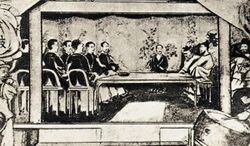Treaty of Sanggyeong
Jump to navigation
Jump to search
 The Treaty of Sangggyeong carried out between the Shindanese and Greater Wu representatives. | |
| Signed | July 17, 1847 |
|---|---|
| Location | Sanggyeong, Shindan (modern-day |
| Signatories | Shindan Empire of Greater Wu |
| Languages | Zhenian |
The Treaty of Sanggyeong (Zhenian: 상경조약) was a treaty made between representatives of the Shindan dynasty and the Empire of Greater Wu towards the end of the Second Shindan-Wu War in 1847, formally ending the war between the two entities.
International Context
Negotiations
Treaty Provisions
The articles of the treaty are as follows:
- Article 1, stating that both Shindan and the Greater Wu were free nations, "as independent states enjoying the same rights as one another". This article clearly stated that Shindan was independent from the Greater Wu for the first time after the Shindan-Wu War of 1715.
- Article 2 stated that a royal wedding between Li Zichuan, then-King of Shindan, and the Princess Sorin of Greater Wu, shall be held 60 days after the treaty. The dowry, as well as all expenses for the royal wedding, would be paid for by the Empire of Greater Wu.
- Article 3 stated that the borders between the Shindan and Greater Wu would be shifted to the borders before 1715, around the Aria River; a transition period of 2 years would be allowed.
- Article 4 specified the establishment of diplomatic envoys between the two nations; however, in the diplomatic communiques between the two nations, only Zhenian would be accepted as the primary language for communication.
- Article 5 clarified the opening of 10 port cities along the coast of the Greater Wu, as well as granting the rights for any Zhenian mariner to conduct surveys and mapping operations along the coasts of the Greater Wu. Such ports are expected to be open by one year after the treaty was signed.
- Article 6 allowed for unhindered trade between the people of the two nations. While the governments of each nation cannot pay off the debts of the merchants of respective nations, the merchants are off to their own to pay their debts if any. It also called for future discussions regarding the trade between the two nations.
- Article 7 laid the grounds for Shindanese merchants being exempt from tariffs of any form in designated ports mentioned in Article 5, while Shindanese merchants were also free to trade all forms of grain. Shindanese merchants were also free to reside and lease land and buildings in the aforementioned open ports.
- Article 8 allowed for the consular jurisdiction and extraterritoriality of the Shindanese people in Greater Wu territory, although vice versa was not approved. Article 8 gave free reins for the Shindanese to live apart from the laws of the Greater Wu.
- Article 9 clarified that Shindanese residents in the revised territories of the Shindan were free from Greater Wu jurisdiction but were subject to the rule of Shindanese jurisdiction instead.
- Article 10 specifies the independence of the Yemeg-Balakhaat Empire that was at the time in a personal union with the Empire of Greater Wu, although the position of Khagan of the Yemeg-Balakhaat Empire had been shifted to King Seongjo of Shindan. Article 10 effectively blocked further Greater Wu incursions into modern-day northern Zhenia.